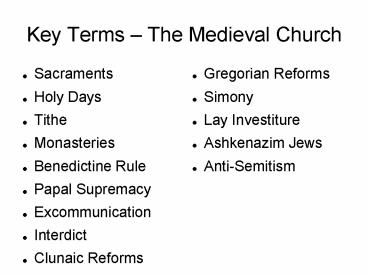Key Terms - PowerPoint PPT Presentation
1 / 12
Title:
Key Terms
Description:
Key Terms The Medieval Church Sacraments Holy Days Tithe Monasteries Benedictine Rule Papal Supremacy Excommunication Interdict Clunaic Reforms Gregorian Reforms – PowerPoint PPT presentation
Number of Views:108
Avg rating:3.0/5.0
Title: Key Terms
1
Key Terms The Medieval Church
- Sacraments
- Holy Days
- Tithe
- Monasteries
- Benedictine Rule
- Papal Supremacy
- Excommunication
- Interdict
- Clunaic Reforms
- Gregorian Reforms
- Simony
- Lay Investiture
- Ashkenazim Jews
- Anti-Semitism
2
The Church
- The Roman Catholic Church became a strong
institution during the middle ages. - Many Christians believed that since the Church
was the only place to offer salvation, it was the
most important institution in the world. - Christians devoted their lives to the Church out
of fear that if they did not attend Church or
receive the sacraments, they would suffer eternal
damnation.
3
The Church
- Life for Christians revolved around the Holy Days
? days that were celebrated as feast days for
saints. - As a result of constant church attendance, the
church would profit by charging tithes ? payments
equal to one tenth of one's income. - Christians had no choice but to go to church
because it was the only place where they could
receive the sacraments ? sacred rites of the
Church.
4
Opinions
- Many believed that the sacraments were the only
way to save one's soul, hence church attendance
was mandatory. - The Church shaped the beliefs of many people.
- Women were diminutized because of Christian
beliefs ? women committed original sin, hence
they were beneath man and needed guidance - Some people believed that the Church had slowly
grown corrupt due to some lay officials becoming
church officials to charge tithes and make
profits ? when rulers or non-church officials
create church offices for others, this is known
as lay investiture. - Lay investiture led many to turn away from the
Medieval Church and join other forms of worship.
5
Growth of Monasticism
- - Many people left the towns to go to monasteries
? communities of men who devoted their lives to
worship. - - Many felt that the corruption of the Church had
not affected the monasteries and hence chose to
live their to lead their Christian lives. - - Corruption would arrive at the monasteries
leading to the need for reform.
6
The Benedictine Rule
- - Many monks broke monastic laws revolving around
gambling and celibacy. - - One abbot, decided to reform the monasteries
and created rules for monks ? these rules were
known as the Benedictine Rule
7
The Benedictine Rule (cont.)
- Some rules were
- 1. Monk must remain at monastery for life
- 2. Daily life should follow a strict schedule.
- 3. Seven hours a day should be devoted to manual
labor. - 4. Two hours should be reserved for reading
Christian books. - 5. Should eat one or two meals a day.
- - These rules were the means by which to
reinforce the three vows of priesthood poverty,
chastity, and obedience.
8
The Growing Power of Popes
- - Popes used the growth of the Church as an
institution as a means by which they could
acquire more power for themselves. - - Popes knew that since there were significantly
more Christians that relied on the sacraments,
they could use this to control rulers and their
actions. - - Popes used two major weapons to control rulers
- Excommunication ? removal from the church of one
individual and denial of the sacraments. - Interdict ? removal from the church of a whole
town or country
9
Clunaic Reforms
- - Abbot Berno of Cluny sought to extend the
reforms brought about by the Benedictine Rule. - - Lay investiture had filled monasteries and
churches with nobles and lay people who were
usually very corrupt. - - Clunaic Reforms ? revived the Benedictine Rule,
removed nobles from monasteries and churches,
invested new monks who were devoted to religion
10
Gregorian Reforms
- - Gregory VII in 1073, would extend the Clunaic
and Benedictine Reforms to the Church. - - Gregorian Reforms ? prohibited the marriage of
priests, outlawed simony ? sale of church
offices. - Ended lay investiture ? investing of titles and
church offices by non-church officials.
11
The Plight of the Jews
- - Jews began to move away from the Middle East
and move towards Spain in search of a safe place
to live. - - Jews who lived in Western Europe were
considered Ashkenazim Jews. - - Jews were welcomed in tolerant Spain because of
their banking knowledge and ability to help
revive economies. - - Persecution of Jews would increase, they would
be blamed for numerous natural disasters and poor
situations ? this prejudice against Jews is known
as anti-semitism
12
Results
- - Popes gained more power during this period and
used it to send secular officials on wars (the
Crusades) and to acquire more power for
themselves. - - The Church became an institution similar to
that of any government that existed during the
Middle Ages. - - Control of the Church would become a major
issue for many secular rulers as they attempted
to invest more power in themselves.































